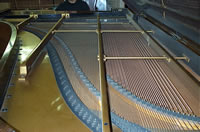Straight-strung grand pianos
Straight-strung pianos were made from the middle of the nineteenth century up until 1927. They do not have a cast-iron frame, but instead have a system of metal bars screwed together called an “ironwork frame”. Their strings are strung parallel to one another, which means they have an extensive vibrating length. Generally their size is in accordance with their design: 180cm, 210cm, 230cm or 250cm. It should be remembered that in a piano, the volume power is directly related to the vibrating length of the strings, particularly for bass notes. These pianos are exceptionally well-designed and compare well with cast-iron framed, cross-strung pianos. Their robustness is an asset in terms of conservation, and means a complete restoration can produce rich musical results. In our opinion, only straight-strung grand pianos from the major French makers such as Erard, Pleyel and Boisselot are worth restoring so that their unique musical possibilities can be enjoyed by period instrument enthusiasts.




